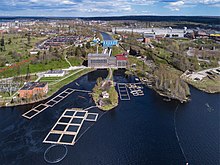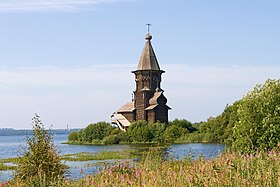Kondopoga
city
|
||||||||||||||||||||||||||||||||||||||||
|
||||||||||||||||||||||||||||||||||||||||
|
||||||||||||||||||||||||||||||||||||||||
| List of cities in Russia | ||||||||||||||||||||||||||||||||||||||||
Kondopoga ( Russian Кондопога , Karelian Kondupohju , Finnish Kontupohja ) is a city in the Republic of Karelia ( Russia ) with 32,987 inhabitants (as of October 14, 2010).
geography
The city is located about 50 km north of the republic capital Petrozavodsk between the Kondopoga Bay of Lake Onega and the higher lake Nigosero . The lakes are connected to the urban area by a canal, on which a small hydroelectric power station has been operated since 1923 .
Kondopoga is the administrative center of the Rajon of the same name .
The town lies on the 1917 opened Murmansk , a day for October Railway of RZD belonging railway from Saint Petersburg to Murmansk (kilometer 456).
history
A village of Kondopoga was first mentioned in 1563 (according to other sources 1495). In the middle of the 18th century , a marble deposit was discovered near the village of Tiwdija . Many of St. Petersburg's buildings were subsequently clad with this marble.
An economic upswing came with the construction of the Murman Railway 1915–1917 and the construction of the hydroelectric power station and a paper mill in 1923. In 1938, the town received city rights with the simultaneous incorporation of several surrounding villages.
During the Second World War , Kondopoga was occupied by Finnish troops on November 3, 1941 and recaptured on June 28, 1944 by troops of the Karelian Front of the Red Army as part of the Swir-Petrozavodsk operation .
At the beginning of September 2006 there were serious ethnic conflicts in Kondopoga between Russian residents and residents of the Caucasus, mainly Chechens .
Population development
| year | Residents |
|---|---|
| 1892 | 600 |
| 1939 | 13,374 |
| 1959 | 16,060 |
| 1970 | 27,908 |
| 1979 | 35,198 |
| 1989 | 36,365 |
| 2002 | 34,863 |
| 2010 | 32,987 |
Note: from 1939 census data
Culture and sights
The 42-meter-high Church of the Assumption of the Virgin Mary ( Успенская церковь / Uspenskaya zerkow) from 1774 was an important monument of northern Russian wooden architecture. On August 10, 2018, it was completely destroyed by fire.
Kondopoga has a local museum.
The nearby Kiwatsch waterfall in the nature reserve of the same name is one of the highest lowland waterfalls (11 meters) in Russia. Not far from the city is the Marzialnye Vody health resort .
Personalities
- Vladimir Stepanov (* 1927), Soviet politician and diplomat
- Marat Tarassow (* 1930), poet and translator
- Viola Malmi (1932–2010), choreographer
- Larissa Lasutina (* 1965 in Kondopoga), three-time Olympic champion in cross-country skiing
- Natalia Dittrich (* 1973), musician and film composer
- Yevgenia Medvedeva-Arbusowa (* 1976 in Kondopoga), cross-country skier
economy
The city's most important company is the Kondopoga AG paper mill (formerly Kondoga cellulose and paper combine ), which produces up to a third of Russian newsprint. There is also wood processing and building materials management.
Web links
- City administration website (Russian), with English history and geography section (see top right corner)
- Kondopoga on mojgorod.ru (Russian)
Individual evidence
- ↑ a b Itogi Vserossijskoj perepisi naselenija 2010 goda. Tom 1. Čislennostʹ i razmeščenie naselenija (Results of the All-Russian Census 2010. Volume 1. Number and distribution of the population). Tables 5 , pp. 12-209; 11 , pp. 312–979 (download from the website of the Federal Service for State Statistics of the Russian Federation)
- ↑ Wikinews: de: Racist Unrest in Russia , September 4, 2006.
- ↑ Wikinews: de: Kondopoga racial conflict extends to Republic of Karelia , September 8, 2006.
- ↑ В Карелии сгорела уникальная деревянная церковь XVIII века




